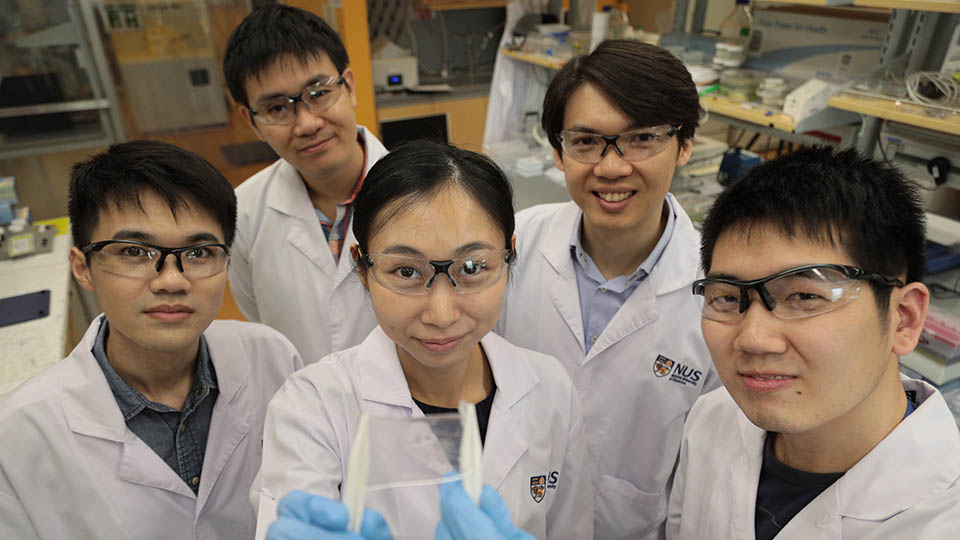
Assistant Professor Tee (back row, right) and his team created a transparent electronic skin that repairs itself in both wet and dry conditions
National University of Singapore scientists have taken inspiration from underwater invertebrates like jellyfish to create an electronic skin with similar functionality.
Just like a jellyfish, the electronic skin is transparent, stretchable, touch-sensitive, and self-healing in aquatic environments. It can be used in everything from water-resistant touchscreens to aquatic soft robots.
The team, led by NUS Materials Science and Engineering Assistant Professor Benjamin Tee, worked with collaborators from Tsinghua University and the University of California Riverside spending just over a year to develop the material. Its invention was featured as the front cover of the journal Nature Electronics on Feb. 15.
Tee has been working on electronic skins for many years and was part of the team that developed the first ever self-healing electronic skin sensors in 2012. His experience in this research area led him to identify key obstacles that self-healing electronic skins have yet to overcome.
“One of the challenges with many self-healing materials today is that they are not transparent and they do not work efficiently when wet,” he said. “These drawbacks make them less useful for electronic applications such as touchscreens which often need to be used in wet weather conditions.”
He continued, “With this idea in mind, we began to look at jellyfishes—they are transparent, and able to sense the wet environment. So, we wondered how we could make an artificial material that could mimic the water-resistant nature of jellyfishes and yet also be touch sensitive.”
They succeeded in this endeavor by creating a gel consisting of a fluorocarbon-based polymer with a fluorine-rich ionic liquid. When combined, the polymer network interacts with the ionic liquid via highly reversible ion-dipole interactions, which allows it to self-heal.
Elaborating on the advantages of this configuration, Tee explained, “Most conductive polymer gels such as hydrogels would swell when submerged in water or dry out over time in air. What makes our material different is that it can retain its shape in both wet and dry surroundings. It works well in sea water and even in acidic or alkaline environments.”
The electronic skin is created by printing the novel material into electronic circuits. As a soft and stretchable material, its electrical properties change when touched, pressed or strained.
“We can then measure this change, and convert it into readable electrical signals to create a vast array of different sensor applications,” Tee added.
“The 3D printability of our material also shows potential in creating fully transparent circuit boards that could be used in robotic applications. We hope that this material can be used to develop various applications in emerging types of soft robots,” added Tee, who is also from the NUS Biomedical Institute for Global Health Research and Technology.
Soft robots, and soft electronics in general, aim to mimic biological tissues to make them more mechanically compliant for human-machine interactions. In addition to conventional soft robot applications, this novel material’s waterproof technology enables the design of amphibious robots and water-resistant electronics.
One further advantage of this self-healing electronic skin is the potential it has to reduce waste. Tee explained, “Millions of tons of electronic waste from devices like broken mobile phones, or tablets are generated globally every year. We are hoping to create a future where electronic devices made from intelligent materials can perform self-repair functions to reduce the amount of electronic waste in the world.”
Looking forward, Tee and his team are hoping to explore further possibilities of this material. He said, “Currently, we are making use of the comprehensive properties of the material to make novel optoelectronic devices, which could be utilized in many new human-machine communication interfaces.”




